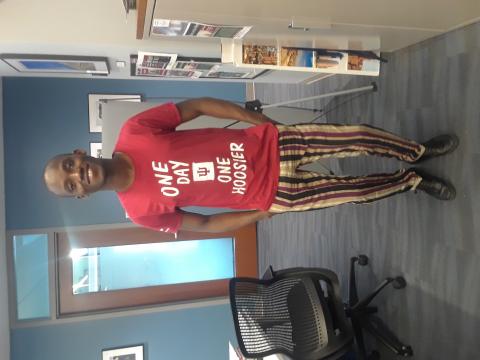You Are, I Am: The Psycho-Social Dimension of Identity
Nov 22,2019
You are invited every 4th of April to my family’s feast of beans. It’s a birthday feast, and I’m pretty sure after attending it the first time, you won’t want to miss the next one. Though beans is not the only food available—you’ll get some water, at least, if you don’t feel like eating the beans—in sixteen years of holding the feast, it has been and will always be the birthday cake more or less. Without it, the feast is not done. But for your information, the feast is not for my own birthday. And I don’t even care much about my birthday!
The feast is for the two usurpers in my family, as I fondly like to think of them. Like the vindicated thief in Ibadan’s praise poetry, however, these are usurpers with honor and dignity. You can’t win them; they have the support of over forty million native Yoruba speakers and religious practitioners in Nigeria, and several millions in the Republic of Benin, Togo, Sierra Leone, Brazil, Cuba, Haiti and North America. They are not to be fought; these twins and usurpers, kings among children.
You don’t have any idea why I call them usurpers, do you? It’s because they took over one of the privileges I ought to have as the first child of the family; the use of my first name to refer to our parents. I’d enjoyed this privilege for only seven years when the two beautiful baby girls came. Everything changed right after their birth, courtesy of the way of my people. They began to call our parents after the collective name of these two beloved sisters of mine, Ibeji (twins). While Mother became Iya Ibeji (Mother of Twins), Father became Baba Ibeji (Father of Twins). That was how I lost a privilege I waited for until the eighth day of my birth when I was named—unlike the twins, you know, I did not come with a name from heaven. My birth was just the regular type; nothing special.
Twins are the cynosure anywhere; they steal the show. But then, like the index finger which the Yoruba use to lick soup, twins don’t enjoy the touch of a soup—the collective privileges identified with them—all alone. In the end, other fingers will be rubbed with the soup when the two hands are washed. My own rub of the soup is that I’m an older sibling to a set of twins. This is a big deal; you could command attention and respect with it. But, guess what; I don’t share the rub alone. My immediate younger brother coming before the twins shares it with me. In fact this rub of the soup my immediate younger brother and I share is so small. The larger portion of the rub is shared by my two siblings born after the twins. They are not only younger siblings to a set of twins; they also brought their own names, Idowu and Alaba respectively, from heaven by the virtue of being born after twins. Between us, I’m sometime jealous of them for this. Their names, like those of the twins, speak for them. What huge fortune! And you can be sure I’m not alone in this feeling of jealousy. My immediate younger brother often says he wishes I and him were born after Alaba so that we could have also brought names from heaven—Idoha and Idogbe.
I’m sure you are amazed by the differences the birth of twins in a Yoruba family could bring about. But this conversation is not just about the twin child among the Yoruba; it’s about identity and what we, humans, make of it.
I don’t need to tell you identity is not fixed. But you might need to know that the fluidness and variability of this phenomenon is—or supposed to be—its beauty, like several colors are to the rainbow. It may also interest you to know that the fluidity of identity is not limited to humankinds alone as the center of life and existence; it’s applicable to every living thing or any entity we can think of. For instance, apart from the onomastic differences across various languages of the world, think of what the lion is to the little child of a Pentecostal pastor in Nigeria, growing up with the stories of Daniel in a lion’s den and Samson killing a lion, and a little child in Kenya whose father, a hunter, was killed by a lion, or whose remote village was often attacked by lions. What is more, think about how much the letters L-I-O-N have become part of your cognitive experience and reaction anytime lion is mentioned. Now you see the picture of lion in your head is not just that animal you saw on Nat Geo Wild, in a zoo or when you went on safari to Tanzania; the picture also includes L-I-O-N, thanks to the invention of writing.
Now you can imagine how much lion and any other animal has changed, just like you and I have, and will continue to because there will always be what Jan E. Stets and Peter J. Burke call salience which activates our role identity in time and in space.[i] Salience could be an event or a development like the birth of my twin sisters. Can you talk about Nelson Mandela without having to reference apartheid? No. Apartheid was the salience that activated the role identity of Mandela as Freedom Fighter and Father of the Nation. 9/11 is a salience to Osama Bin Laden. From Sully Prudhomme to Kazuo Ishiguoro, think of how many people the Nobel Prize in literature has been a salience to. Without even thinking of other areas in which the prize is given, the number will also include Alfred Nobel himself!
I’m sure you can now give several examples of salience. Buy you need to note that salience is not only about big events or developments. It’s any action or inaction, of or around human that activates role identity. More so, it could be interpreted differently. It is among the Yoruba, for instance, that twins are so much revered. But, according to historical accounts, there are ethnic groups within and even outside Africa that, used to kill twins after their births because they saw them as evil children. The birth of twins is the salience in these two cases but they have different interpretations.
What this demonstrates about Stets and Burkes’ identity types—person, role and group—and their activator, salience, is that beyond them is what James Paul Gee explains as the perspectives of identity, namely; nature perspective (N-Identity), institutional perspective (I-identity), discourse perspective (D-identity) and affinity perspective (A-identity).[ii] The nature perspective, to give a quick comment, is rooted in the forces and powers of nature. Generally, person and group identity are based on this perspective. That is, it identifies every human based on such basic identity markers as sex, complexion, height, size, age, language, family, tribe/ethnicity, caste, nationality, and race and, to a large extent, religion. Other perspectives relate much to role identity.
I-identity, I feel, is the strongest of all because it can easily influence other perspectives. Taking its powers from authorities within institutions, this perspective could give an indelible role to a person or group in any given context. Hence, it is a perspective that can make or mar a person or group. It is this perspective that requires Laura Esquivel’s protagonist, Tita, as the last daughter of her family never to get married but spend the whole of her life taking care of her mother, through whom the perspective—which is a family custom—is manifested.[iii] The perspective also plays out in the role identity of the twin child among the Yoruba. Here, it is the autochthonous authority of the Yoruba nation which had shaped the worldview, belief and value system of the Yoruba. This perspective thus further influenced the discourse/dialogue among Yoruba people on twins as evident in poetry, songs, myths, victuals, religio-spiritual attachment, and other related cultural practices and products.
It is instructive to add that even if a role assigned to a person or group through I-identity is contestable, it might still remain very hard, if not totally impossible, to change it. Such role is also seen in the example of the twin child among the Yoruba, and this role is the recognition of the second in a set of twins as older than the first. You’re not alone in thinking this is far-fetched and funny; I and even many contemporary Yoruba first siblings among twins, as in the case of my sisters, also share the same thought.
Bio-medically—I believe I’m speaking your mind right now—this is not true. But the bad news is that the discourse perspective among the Yoruba, having been influenced by institution perspective, takes this to be true. Ask the Yoruba why this is the case, and you’ll be seated down to listen to the myth of how during the birth labor, the second in a set of twins, who is considered by the Yoruba to be stronger, kicks out the first to go taste the world as evident in the name the latter brings from heaven, Taiwo (full form; Tayewo—Taste the World). The second, Kehinde (full form; Omokehinde—The Child Comes out Last) comes out of the mother having had the assurance that the world it is coming into is good. If the life wasn’t good, Taiwo whom it kicks out with the instruction to go taste the world would have come back to report this!
Now it is clear, I believe, that the complexity the phenomenon of identity is, is actually much largely resident in role identity in relation to such perspectives as institution, discourse and affinity. Suffice to say that the interrelation of role identity and the three perspectives is what brings about the psycho-social dimension of identity, the part of human—to limit myself to our kind alone—identity being pointed out when identity is said to be complex and fluid.
You think I’m only making a fuss about the complexity and fluidity. Let’s tarry a while then, by going back to ‘our kind’. Using this phrase shows I’m no longer including (lower) animals in this conversation, right? I’m not including those creatures that are far away from the center of life and existence. Not even the intelligent and quite friendly dolphin! The conversation is now all about Homo sapiens. Now after exterminating all animals, what picture of ‘our kind’ do you see? A broken one, you’ll agree with me. This is so because the extermination is a salience that will begin to reveal the wide, hitherto unseen, differences in our kind. So, this is the psycho-social dimension of you and me; an endless fragmentation of our kind.
This fragmentation of our kind is far from being about the onomastic representation of the basic person identity markers from nature perspective earlier identified. Rather, it’s about the role attached to the person based on any of these basics. Role could be how a person is treated through affinity perspective as Kafka’s father does to his son,[iv] or, as members of higher castes do to members of lower castes in India, if I did get Arundhati Roy clearly.[v] This treatment could also come through the institution perspective as in the criminalization of African Americans by successive governments in the United States and, consequently, the majority of white American population (being an affinity group to the black population) as claimed by Richard Wright,[vi] Ta-Nehisi Coates[vii] and Ava DuVernay.[viii]
Role could also have to do with meaning, such as the meaning of ‘fat’ as in size from the discourse perspective of the United States as opposed to say that of Nigeria. If you don’t get the gist here, then you’ve not read what Chimamanda Adichie has to say about it.[ix] Here, you’ll also get to know about how due to the co-existence of various racial groups as a salience, affinity perspective on hairstyle and complexion gives meanings to who a person is and how they are treated in the United States. How about even within a group; racial for example? The fragmentation, of course, never stops as evident in the example of sex and gender. One thing is to be white or black; another thing is to be a woman. I believe you know the stories about this perhaps better than I do.
The psycho-social dimension of identity, as seen in the foregoing, is constituted by salience and the interrelation of role identity and institution, discourse and affinity perspective. This interrelation endlessly acts on salience by interpreting it and giving roles. Thus, studying its operation could help in understanding how to address the challenges—stigmatization, stereotyping, victimization, among others—our modern human society has been dealing with all in the name of identity. To me, these challenges are all about “You are” versus “I am”. This is because their consequences have an individual human each, at their receiving end.
“I” is a singular pronoun, right, and “You” can be both singular and plural? That’s exactly how I mean to use them. The consequences of the use of “You” either as plural or singular, are borne by “I”. For instance, saying “You are useless, lazy, or evil” to a human group as a race, nation, caste, family, age-grade or religious group is, in its wide-reaching implication, a role identity for each member of the group. This action cannot be justified.
You’re thinking who cares if a group is stigmatized (since it’s not yours I guess)? Well, when we humans divide ourselves from each other, we’re dividing ourselves each from within. Think of how Christians and Muslims are divided from each other, and then how they are each further far divided from within through different sects and denominations. Now imagine what this has done to “I” in each religious group.
The need to protect the human essence of the individual person must therefore be an utmost concern of our kind. We mustn’t let identity strengthen the “savage infancy” in us but illuminate “the Light within each of us” towards actualizing a “World of Homelands,” a “humanly inclusive world,” says Michael Vickers.[x] Otherwise, you and I, we, will all be treading an abyssal path.
Quite enough of my long talk. Now let’s take a break and go catch flies. But don’t use the hand where you keep the date, April 4.
[i] “Identity Theory and Social Identity Theory,” Social Psychology Quarterly 63. 3:224-37.
[ii] “Identity as an Analytic Lens for Research in Education,” Review of Research in Education 25, (2000) 99-125.
[iii] Like Water for Chocolate (New York: Ramdom House), 1992.
[iv] “Letter to His Father,” in Frank Kafka, The Son, (New York: Schocken), 1989.
[v] The God of Small Things, (Glasgow: Caledonian International Books Manufacturing Ltd), 1997.
[vi] Native Son, 1940 and Black Boy, 1945 (New York: Harpers and Brothers).
[vii] Between the World and Me (New York: Spiegel and Grau), 2015.
[viii] 13th (Los Angeles: Kandoo Films), 2016.
[ix] Americanah (New York: Anchor Books), 2013.
[x] Looking Back from the Future: The View from Onitsha—Message to my Children (Austin: Pan-African University Press), 2018.






